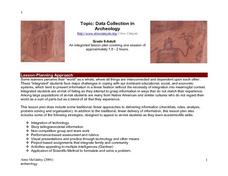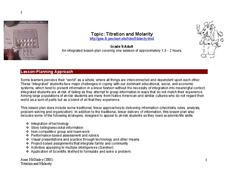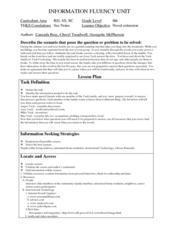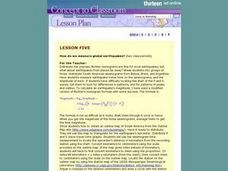Curated OER
Ecology Integration Using IMovie
Amazing! Any 5th grader would be more than willing to participate in this project. Students are broken into groups, each group reads one book from a list of five. They use their book as the basis for choosing an animal and environment to...
Curated OER
The Causes of Prohibition
Eleventh graders explore the origins of the Prohibition Movement in the United States. In small groups, they analyze the influence of World War I in the passage of the eighteenth amendment. Students explain how different demographics of...
Curated OER
Cooking Lesson
Fourth graders taste different flavors on their popcorn. In this taste bud lesson plan, 4th graders make predictions about taste and dip popcorn into four different flavors. They record how the flavors tasted - sweet, salty, bitter, or...
Curated OER
The Way Animals Move: Fly, Crawl, or Swim?
Students use "Kid Pix" to stamp and sort animals in groups to show the way animals move: fly, walk-slither-slide-crawl, or swim. They need to have knowledge of a variety of animals and how they move from one place to another.
Curated OER
Data Collection in Archeology
Students become familiar with the fascinating world of Rock Art. They focus on images from SE Utah, this is where the pictures were taken. Students are encouraged to use Power Point and Access file as a guide, they explore the early...
Curated OER
The Effects of Ultra-Violet Light on Yeast
Learners work in small groups collecting and analyzing data as they learn how to best grow yeast. This lesson allows students to conduct several student-created experiments as they continually generate questions and hypotheses. ...
Curated OER
Building a Volcano
Students research volcanoes and then build one out of salt dough. Before the final step is completed, they find main ideas about volcanoes, write sequential steps to building, use correct grammar, to gain knowledge about them. There is...
Curated OER
Health Wheel Self-Care Plan for Diabetics
Young scholars help create a Health Wheel: a personal, inspirationally based, self-care plan for preventing or managing diabetes in daily life. They (student or client) researches the causes of diabetes, and creates a "health wheel" that...
Curated OER
How Atoms Work
Students explore the concept of atoms and how they combine to form molecules and compounds. In pairs, they read an article on how atoms work and discuss the main points. They draw atoms and write a paragraph about their elements.
Curated OER
Titration and Molarity
Students investigate the concept of molarity and its relationship to the concentration of a solution. After mixing chemical solutions, they calculate how many moles of acid and base should be in each solution. They record their results...
Curated OER
Math, Chemistry, and Food
Students explore the effects of chemical reactions when cooking. Using the Internet, they research enzymes and then mix jello. They examine their results and test enzyme activity by adding pineapple to the jello. Finally, they test...
Curated OER
Environmental Voting Records of Legislators
Students collect and record data on the environmental voting record of their local and state legislators using the Internet. They identify examples of environmental problems or endangered species in their state.
Curated OER
Oil on the Beach
Students explore how oil pollutes the oceans. In this science lesson, students investigate various materials that could be used to clean up an oil spill. Students discuss which materials worked best and how humans can reduce oil spills.
Curated OER
Bodaciously Beautiful Butterflies Take Flight
Young scholars complete study on butterflies using real caterpillars, keep individual daily journals of observations, and complete timeline for their caterpillar/butterfly.
Curated OER
Novel Extension
Sixth graders play the role of meeting Tuck Everlasting. They prepare to answer that person's questions. They determine that each member of the family wants to know about a different thing.
Curated OER
Observations and Inferences
Students observe how to distinguish observations form inferences. In this examining inferences lesson students list observations relating to the activity and discuss the importance of them.
Curated OER
How do we measure global earthquakes?
Young scholars examine three seismograms of a recent South American earthquake recorded by USGS stations. They measure the S-P distance and use a P and S wave travel-time graph to find the epicenter distance for each seismogram. In...
Curated OER
Elements of Biology: Biomes
Young scholars describe the different types of biomes. In this biology lesson, students create a map of assigned biome with descriptive paragraphs. They share their findings to class.


















